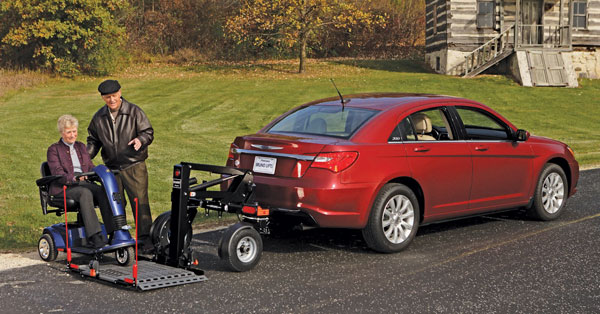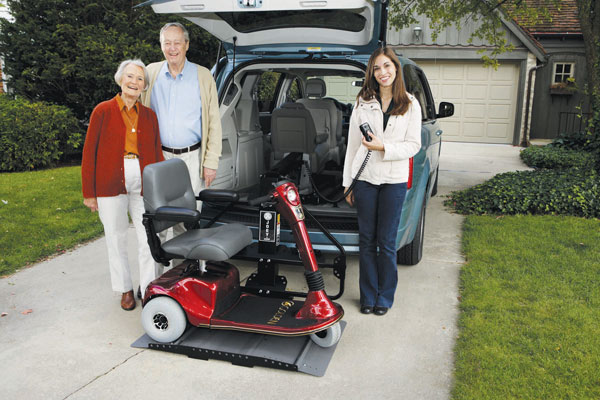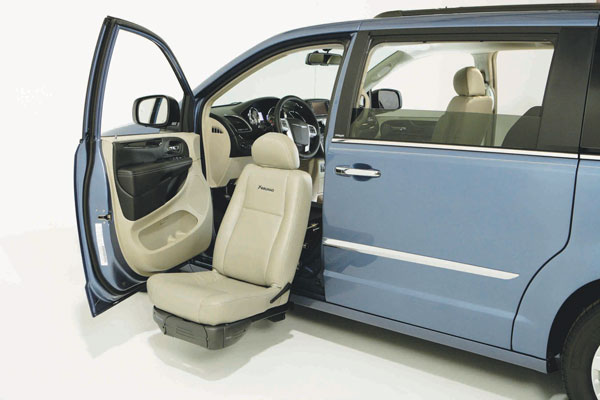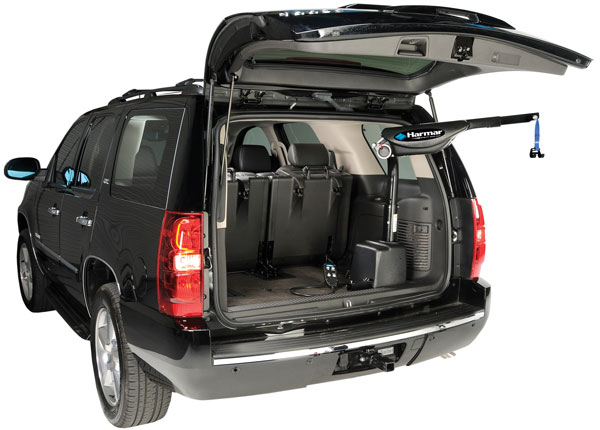The invasive tentacles of competitive bidding do not stretch to the realm of vehicle lifts, but that doesn’t mean the effects of the reviled government program are not being felt. In fact, the absence of competitive bidding entanglements has served to attract providers to the cash-based world of lifts and accessories.
Driving Cash Sales
These days a steady number of HME providers are calling lift manufacturers every month, a sure sign that the market is searching for alternatives. “The calls are an indicator that they’re scrambling,” says Mike Krawczyk, marketing manager at Bruno Independent Living Aids (www.bruno.com), which is located in Oconomowoc, Wis. “They’re afraid that all of their products will have to go through the bidding process.”
Call it scrambling or the much-hyped Baby Boom generation, but it added up to record sales in 2010 for Bruno. The following year was even better, and 2012 is shaping up to be another record breaker. Krawczyk attributes the success to a basic formula of quality products, high demand and consumers who are willing and able to spend money.
People in their 60s and 70s are experiencing knee and hip problems, and Krawczyk believes Bruno products tend to appeal to this crowd. “Our products fill that market niche nicely—especially units such as our Valet Signature seating,” he says. “Those are seats that rotate out of a vehicle and then down, making it easier for people to get into and out of high-riding vehicles. The market for these remains very strong.”

The Right Mindset Matters
During an unprecedented push toward retail in the HME business, it’s tempting to view vehicle lifts as just another safe haven from competitive bidding. In some ways, that is true, but it’s not that simple.
Cy Corgan, director of retail mobility at Pride Mobility, Lifts and Ramps (www.pridemobility.com), cautions “this is not a category for just anybody who wants to do more retail business.” Unlike the latest pain management device, vehicle lifts require a lot of training, space and an understanding of the market.
Fortunately, gaining these attributes is not impossible with the right mindset. “This market requires a shop where you can pull vehicles in and out of the weather,” says Corgan, who now devotes most of his time to the Lifts and Ramps division at Pride. “You need skilled technicians who have gone through certification such as our Pride Vehicle Lift certification program. Installation, troubleshooting, service after the sale—it’s an involved category, and it’s not for every provider.”
Certification training usually encompasses a full day of installing, uninstalling and electronics education. Pride may soon be hosting a new certification course at its headquarters in Exeter, Pa. The first will likely take place before the end of the year, with three or four courses per year after that.
Like so many other specialized markets, success requires a dedicated employee to explore advertising and partnerships. In this case, auto dealerships, occupational therapists (OTs) and physical therapists (PTs) are good starting points. “You must have a vehicle lift champion at your location,” says Corgan. “It’s not easy. You must promote the category so people know about it.”
“The biggest reality is that no matter how big the vehicle lifts niche becomes, it is always going to be comparatively small,” adds Krawczyk, who was an advertising executive prior to arriving at Bruno seven years ago. “It is unrealistic to get an average American to have any concept of what a vehicle lift is. I can’t advertise Bruno products nationally so that everyone knows what they are. I don’t have that budget.”
Instead, Krawczyk expands awareness by going out and meeting with regional OTs and PTs. If the OTs and PTs know about the products, he reasons that they will be quick to recommend them to clients.
In addition to attacking the market at an “indirect angle” through therapists, creating alliances with area automotive dealers is crucial. “If one auto dealer had a champion for mobility, he could work with HME dealers and both parties could do very well,” muses Krawczyk. “Not all dealers and auto dealers understand how lucrative it can be. Convince an auto guy to be the champion for customers who come to the dealership in a wheelchair or scooter. That is niche marketing.”

Keeping Up to Speed
Cy Corgan makes it his business to know what Detroit is offering and what Americans are buying. His attention to detail is critical, because today’s vehicles present numerous challenges. Vehicles with false floors and “stow and go” seating demand the ability to adapt quickly to properly fit and interface with equipment.
Corgan gets specs from manufacturers and occasionally even goes out to car lots. “We work closely with the local auto malls,” he reports. “We secure the vehicle for a few days, bring it into our location here and do all the measuring to see how we can create an application for that vehicle. Sometimes it is very challenging with the false floors and uni-frame designs. There is not a lot of area to bolt down to. Auto manufacturers are trying to make vehicles lighter to improve gas mileage, but it’s up to us to meet the needs of consumers.
“We closely watch the Detroit car show and see what the hot sellers are,” he adds. “Then we quickly go out and obtain that vehicle because we know we are going to get calls on those vans, SUVs and pickup trucks, so we must have a lift that will install in that vehicle. We send someone to walk the floors at the auto shows to see what will be hot in the coming years.”
For Krawczyk, the culmination of extensive research and development can sometimes result in frustration, particularly when imitation products appear. “We spend a great deal of time and money doing rigorous testing of our products with independent testing companies before we bring them out,” he says. “We know for a fact that a lot of competitors don’t go to that extent to test their products. A year later a competitor comes out with a product that looks identical. That is a little annoying, and it’s unfortunate for the end user.”

Innovation Abounds
At Sarasota, Fla.-based Harmar (www.harmar.com), company officials are touting a next-generation outside vehicle lift designed specifically for mid-wheel-drive power chairs. “The AL580 is about 30 pounds lighter than other models, which is significant because many more vehicle/power chair combinations can be accommodated, or a convenient swing-away added, whereas otherwise it might be too heavy,” says Paul E. Johnson, vice president of sales, marketing and services. “Additionally, with the small profile of its platform, it doesn’t obstruct the driver’s rear view when folded up.”
At Bruno Independent Living Aids, the exterior platform lift on wheels known as The Chariot continues to do well. “It rides directly behind a small or mid-size vehicle with its own independent suspension,” says Mike Krawczyk. “It’s the first time ever that a small to mid-size car has the ability to transport a 350-pound scooter or power wheelchair. The Chariot directly attaches to the vehicle with a class one or class two hitch. There is no ball joint, so it’s not a trailer that swings back and forth. It stays directly in line behind the vehicle.”
“We have an exterior lift called the Outlander, and it’s now going to be called the Outlander Plus due to its added durability, function and aesthetics,” says Cy Corgan at Pride Mobility. “Another product launching in September 2012 is the Commander 400. The Commander 400 is a 400-pound capacity product. This will be our first real contender in that boom category, but also allows us the ability to lift the heavier group 3 power chairs.”

Sidebar
Joining Forces
Objective and subjective indicators point to a healthy market for vehicle lifts and auto accessories. While most of that positive growth has come organically, some manufacturers seek to fill product holes with acquisitions.
According to Mike Krawczyk, marketing manager, the ownership group at Bruno—which is made up primarily of the Bruno family—bought a significant portion of The Braun Corp. about two months ago.
“Bruno has a substantial stake in Braun now,” he says. “Both Braun and Bruno will work as totally separate companies, and nothing will change with their marketing or ours. We are not direct competitors for the most part. Braun is the single biggest, and we believe the single best manufacturer of lower floored vans and ramp systems. We don’t do any ramps.”
On July 25, the investment bank Harris Williams & Co. announced the sale of vehicle and residential lift manufacturer Harmar Mobility LLC to Cortec Group. Cortec is a New York-based private equity firm that acquires high value-added, lower-middle market specialty manufacturing, distribution and service businesses with leadership positions in their market niches. Harris Williams & Co. advised Harmar on the transaction, which closed July 20, 2012.




